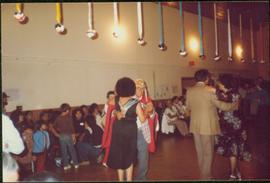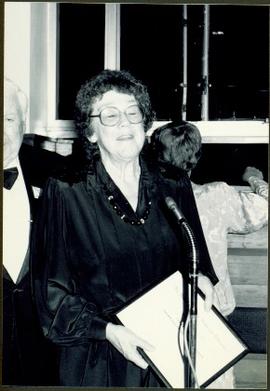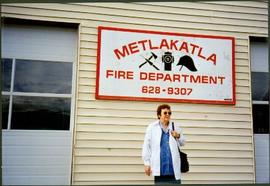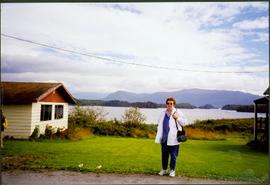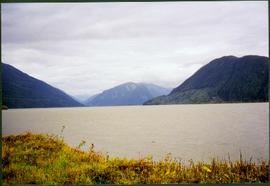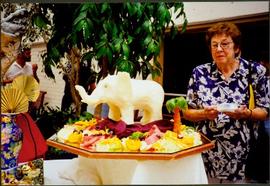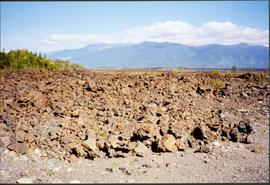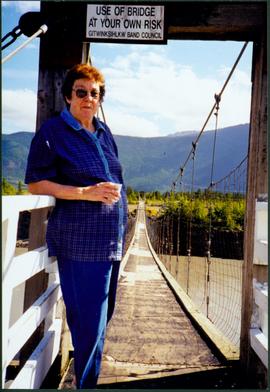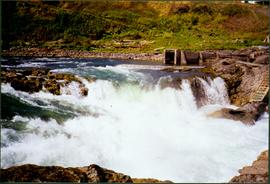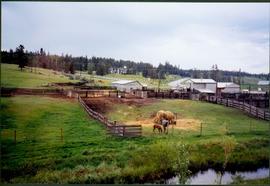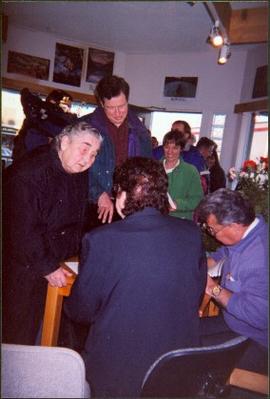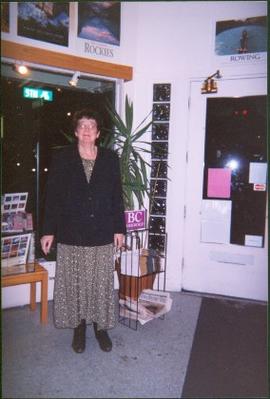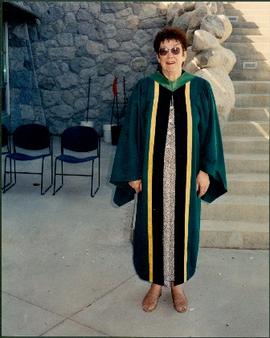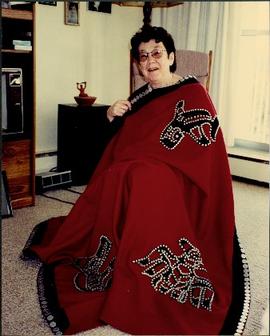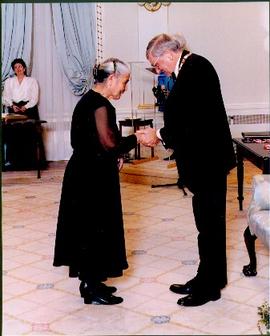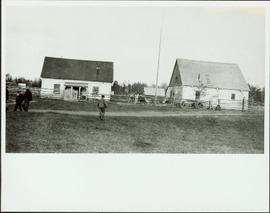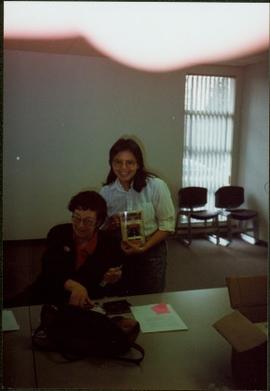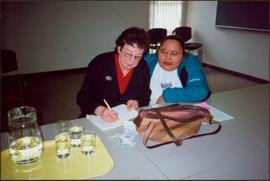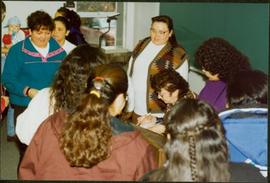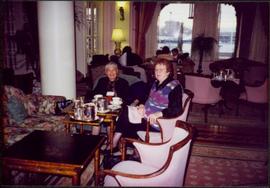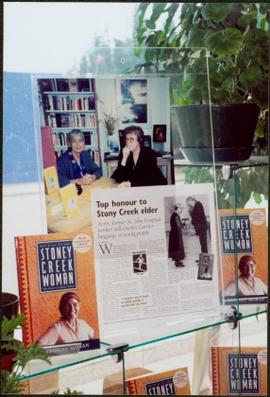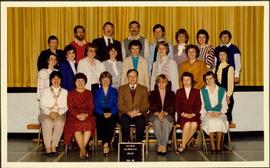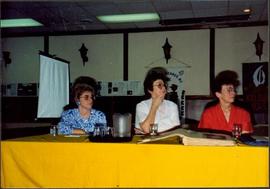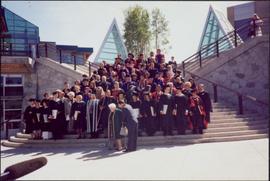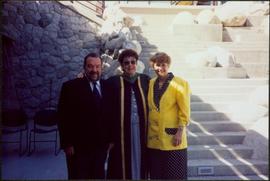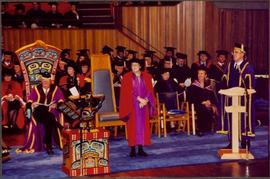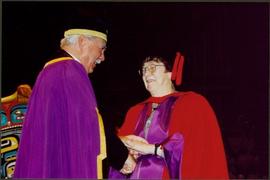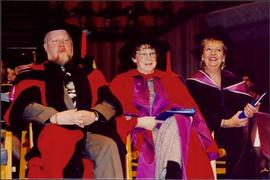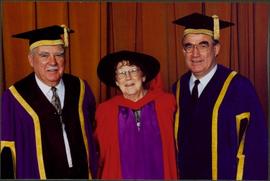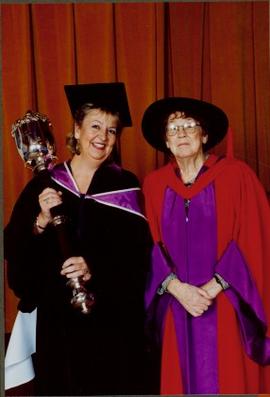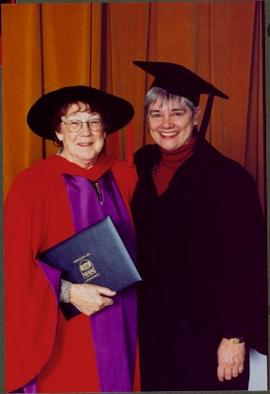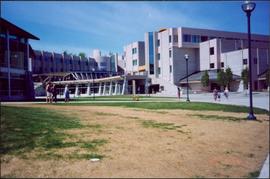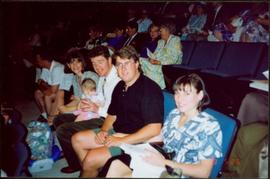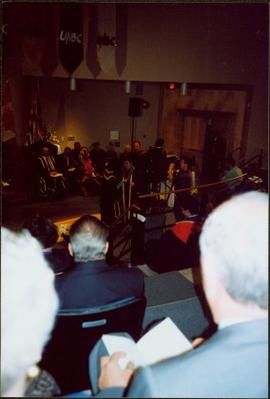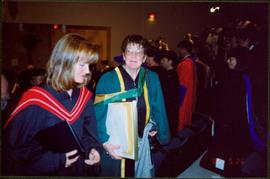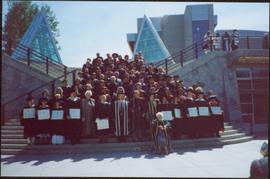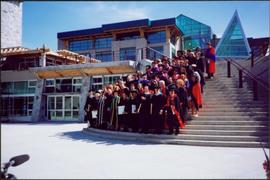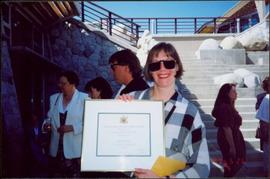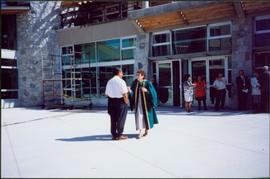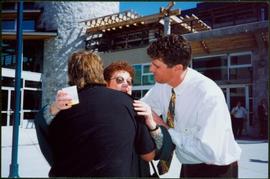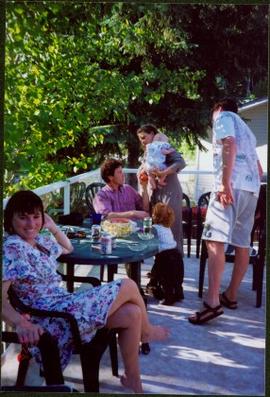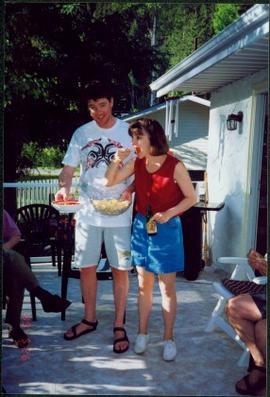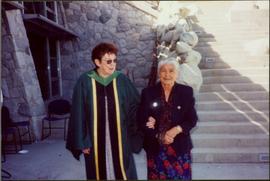Photograph depicts couples dancing in large room, crowd seated on chairs against wall in background. Ornaments are hung in a row from ceiling. Man dancing in centre wears traditional dress. Handwritten annotation on recto of photograph: "Elders gathering 1983".
Handwritten annotation on recto: "Bridget Moran thanks the B.C. Historical Federation for recognizing her as best author of 1988." Moran stands behind microphone, holding award. Don Sale and Naomi Miller of the B.C. Historical Federation Writing Competition Committee stand in background.
Moran stands in front of building with the sign "METLAKATLA FIRE DEPARTMENT 628-9307".
Bridget Moran stands on road, unidentified buildings behind on either side. Lake and hills on opposite shore in background. Photo believed to be taken at Metlakatla Lake, B.C. Building on left speculated to be the St. Paul's Anglican Church Learning Centre.
Photograph depicts unknown lake. Grassy shore in foreground, mountains in background.
Photograph depicts Moran standing in floral print dress, holding plate of food by fruit platter featuring a carved elephant and palm tree. Party decorations and tree can be seen in image. Building and unidentified men stand in background.
Photograph depicts what appears to be a lava bed, see item 2008.3.1.22.33.
Photograph depicts Moran standing in front of bridge featuring a sign reading "USE OF BRIDGE AT YOUR OWN RISK / GITWINKSIHLKW BAND COUNCIL". River below, hills on opposite shore in background.
Photograph depicts white rapids at bottom of waterfall in Bulkley River, B.C. Fishing territory visible on far right; hill on opposite shore in background.
Photograph depicts two horses in one of many fenced areas, buildings and machinery in background. Highway, house, and forest also visible in distance.
Photograph depicts Justa Monk and Bridget Moran seated at table, signing copies of 'Justa: a First Nations Leader'. The pair faces crowd standing in background. Windows and posters visible behind crowd.
Photograph depicts Moran standing in bookstore. Window, door, and plants in background. Photo taken at book signing event for Moran's 'Justa: a First Nations Leader'.
Photograph depicts Moran standing in front of stone steps in Agora courtyard at the University of Northern British Columbia, in Prince George, B.C. Photo taken on the day Moran received an Honourary Law Degree.
Photograph depicts Moran seated in chair at unknown location. Red and black button blanket features traditional thunderbird, wolf, and killer whale designs. Television, armchair, and window visible in background.
Photograph depicts Mary John shaking hands with unidentified man at official ceremony where she was awarded the Order of Canada for outstanding service to her community. Two unidentified woman stand in background in large ornately furnished room.
Photograph depicts two buildings behind fence, sheds visible in background. Unidentified men can be seen walking in foreground. Small structures believed to be teepees can be seen behind fence.
Photograph depicts unidentified woman holding copy of Moran's book, standing behind the author. Table in foreground, window and chairs in background.
Photograph depicts Moran seated to left of unidentified woman at table with glasses and pitcher of water. Window and chalkboard in background. (Woman also featured in item 2008.3.1.102.2).
Photograph depicts Moran seated amongst standing group of unidentified women. Overhead machine and chalkboard in background. Photograph was taken at session of Aboriginal Women's Training Program at the Cowichan Campus, Malaspina University College, in Duncan B.C.
Photograph depicts Mary John seated to left of Moran at table in large room with tables, chairs, and couches. Skyscraper and water visible through window in background. Accompanying note reads "Tea at the Empress! Feb/97"
Photograph depicts numerous copies of 'Stoney Creek Woman' (by Bridget Moran) in glass case. Display also features article on Mary John's receipt of the Order of Canada (see items 2008.3.1.22.61 and 2008.3.1.22.64 for photographs displayed in this image).
Item is a recorded audio interview with Justa Monk.
Audiocassette Summary
00’ 10” Continuation of Tape 2. Justa discusses the review of the Kemano project. He wants a public review where there is First Nations representation. He is frustrated by the lack of a working relationship and being recognized as a leader.
03’ 29” Their way of life is damaged from the flooding. Graveyards were flooded in the 1940s. Fishing grounds will never be the same. Kemano II will do the same damage to a narrower piece of land. Seven communities will be affected, particularly Stoney Creek, because there will be no more fishing grounds.
08’ 27” They are doing this for more electricity, not for the aluminum. BC Hydro made a deal with Alcan for a bigger reservoir. Moran asks Justa if BC Hydro is the ‘imp in the woodpile.’ Justa tells her there is a three-party agreement between Alcan, BC Hydro, and the provincial government. He tells her the project will not go ahead because he believes the Supreme Court will rule in their favour.
15’ 05” Moran mentions Mary John saying that everything the First Nations ‘ever got they had to fight for.’ They briefly discuss Oka. Justa returns to discussing the Kemano II project.
16’ 53” Moran asks Justa about the Aluminum Company of Canada.
17’ 49” They both talk about the Indian Agent that would not let First Nations people in his home. They both relay their disgust with a specific Indian Agent.
18’ 41” Moran asks Justa about the Carrier-Sekani land claims. He discusses having to revisit the boundary lines. Justa talks about an agreement he signed on September 21, 1992, where there would be proper representation for the First Nations people.
26’ 30” Justa discusses the ‘potlatch law’ which he describes as ‘love, share, and respect.’ He talks about how he often gets a good response from groups he teaches.
34’ 51” Moran tells Justa how she was contacted by the Stoney Creek Band regarding how they collected several stories that are unreadable. They have asked Moran to somehow transcribe them properly.
36’ 37” Moran asks Justa about the Kemano II decision from the Supreme Court. He talks about how he is disappointed in the decision, but said he expected it because the government has rarely ruled in favour of First Nations issues.
43’ 16” Justa tells Moran that he was written a letter to President Bill Clinton and Vice-President Al Gore extending an open invitation to see the damage the Kemano II project has done to the environment.
45’ 03” Moran asks Justa when he returned to Tachie to work. He discusses his work there. In 1969, he began work at BC Rail. He moved to Dawson Creek with Theresa and their family.
51’ 09” Moran asks Justa about returning to the village of Tachie, particularly with the trouble that had happened with his brother. He talks about how the elders believed that everything would work out and how many of his achievements relate to that philosophy.
54’ 37” Moran asks Justa about his maintenance work for BC Rail. He describes his position in detail.
59’ 44” Moran asks Justa about the great gardens his father had grown, but this has stopped because of the road. He talks about bringing in television to the community. He talks about when hydro came into the community in the early 1970s. He talks about the water and sewage system being implemented in the mid-1970s.
1:05’ 10” Justa talks about when he became band manager in 1973. He describes his position. Moran asks about the difference between band manager and chief. Justa describes the difference.
1:13’ 21” Moran asks about whether or not Justa had to deal with Indian Agents or the DIA during that time. He describes his band manager position further as being a marriage counsellor, policeman, secretary, a bouncer, and always trying to make peace within the community. He talks about the pressure of the position, and how it made his alcoholism worse, how he was on sleeping and nerve pills.
1:21’ 31” Moran asks about the population of Tachie. She asks about the location of Grand Rapids.
1:22’ 33” Justa talks about becoming chief in 1975, but also kept the band manager position. He discusses in detail about being both, particularly with social issues. He talks about how parties often ended up in some accident ie a little girl getting shot.
1:28’ 34” Moran asks about the isolation of the community. Justa discusses calling for a boat or a plane to evacuate someone in case of an emergency.
1:30’ 10” End of tape.
Item is a audio interview recorded by Bridget Moran with Justa Monk.
Audiocassette Summary
00’ 10” Moran asks about when the roads were built to Tachie. Justa talks about the length of time it took to get to work from Tachie to Portage before the roads were built. After some people drowned, the pressure was put on the Department of Indian Affairs to build a road. Justa talks about his trips before the road was built.
07’ 42” Moran asks about why Tachie was not built around Stuart Lake but at the mouth of the creek. Justa gives a brief history of Tachie.
09’ 20” Moran asks Justa about the history of his father, particularly what his jobs were.
11’ 01” Moran asks Justa what Camp 24 is, where his mother and father stayed at times. It was a camp owned by the Roman Catholic Church where people could stay while they worked in the bush. Justa says the camp was more of a settlement. Moran and Justa continue to talk about the living conditions of Camp 24.
16’ 47” Moran asks Justa about his father’s mother. Justa never met his grandmother, even though his father continued to visit her. They continue to talk about the history of Justa’s parents.
20’ 10” Moran tells Justa she has heard there are no more gardens in Tachie today. Justa tells Moran that people no longer live off the land and that is why the gardens no longer exist. Justa says he feels lucky that he was able to experience life by living off the land. Moran asks about how home brew is made. Justa gives a list of the ingredients and how it needed to sit for twenty-four hours before being able to drink it.
25’ 00” Moran asks Justa about what his first memories of Fort St. James were. He talks about his childhood memories and his first experience in driving in a vehicle.
29’ 58” Moran asks Justa about how many families are in Portage. Fifteen to twenty are there, which Justa says is bigger than when he was growing up. There is a problem of over-crowding with about 300 people living there.
31’ 14” Justa talks about going into the cellar to collect stuff for his mother, such as jams. He talks about how his parents never ate any canned food, and always continued to live off the land. Justa continues to talk about the relationship between his parents and how happy they were together, how they rarely argued. When his mother passed away, his father passed away shortly after because he stopped taking care of himself.
36’ 44” Moran asks Justa about fishing. Justa talks about fishing from a reef in the fall. Justa would smoke the fish in a tent that other people had set up. He talks about living off the land, where nothing was wasted. In the winter, he would ice-fish.
41’ 00” Justa talks about how he enjoys going back to the old way of life and is looking forward to finishing his leadership position, so he can return to the old ways. He talks about rehabilitating his mind and body because he is burning out from his busy schedule.
43’ 06” Moran asks if she can talk to Justa’s sisters and a friend of his family. Justa tells her that his sisters are looking forward to speaking to her. They talk about the benefits of aging.
47’ 08” End of tape.
Item is a audio interview recorded by Bridget Moran with Justa Monk.
Audiocassette Summary
00’ 10” Moran is talking to Theresa, Justa’s wife. Moran asks her what Corpus Christi means. Theresa tells her it is a place where First Nations people from the area planted trees in a big circle. It was a prayer circle where the bishop would say mass.
05’ 10” Moran asks Theresa about Sports Day in Fort St. James, which was more like a rodeo.
06’ 17” Moran is now talking to Justa. Moran asks Justa about trips to Babine Lake that Jimmy previously mentioned. Justa does not remember the trips, but he imagines they were very cold.
09’ 17” Moran asks Justa about the store Jimmy used to run. Justa tells Moran the store was operating on the store credit, hence the downfall of the business. They continue to talk about opening a store in Tachie that is operated by someone with a strong business mind.
13’ 37” Moran asks Justa about a family member from Burns Lake that his sisters previously mentioned. Justa tells her that the family member is an aunt.
14’ 34” Moran asks Justa about the residential school. She enquires about his ability to play hockey. Justa never wore skates until he attended residential school.
16’ 03” Moran asks Justa about fishing with a safety pin. He tells her that one Indian can eat anything.
16’ 53” They return to talking about residential school and if Justa had ever returned. He went back when he was forty-five to visit the area.
18’ 34” Moran asks about the house his family used to live in. Justa is not sure about his brother’s story regarding the Hudson’s Bay Company. He is sure that the house they lived in was built byt heir family.
21’ 01” Moran asks about Justa’s brother who passed away when he was quite young. Justa says his mother told him his brother fell off the roof and broke his neck. They talk about Justa’s brother, Teddy, being killed.
24’ 04” Moran asks Justa about the community making their own snowshoes. Justa tells her what they made the snowshoes out of – deer hide, cow hide, moose hide. Justa talks about going out on the trap line with his father in his homemade snowshoes.
26’ 21” Moran asks Justa about his previous employment from 1957 on. He gives a chronological account of his employment history until 1967, when he went to jail. After 1969, he continued to work. He always worked. They continue to talk about his past employment.
39’ 32” Moran asks Justa about his social life between 1957 and 1967. He tells her that he had a good time. He started to drink at seventeen.
40’ 53” Moran asks about Justa’s brother Teddy and their relationship. Justa tells her they were close, like twin brothers.
41’ 52” They talk about his alcoholism and how it led to fighting. Justa continues to talk about his drinking days and how much trouble it caused him. He also talks about how his parents tried to discourage drinking between him and his brothers. His parents were not worried about his sisters because they settled down early.
48’ 52” Justa talks about how often he saw his family, particularly his parents, during that time period. He says he always felt close to his family, no matter what happened.
50’ 27” Moran asks Justa about how he earned a dollar a week leading children to the residential school. They talk about his arm being broken in the last year he attended residential school. He talks about playing hockey throughout his time at residential school.
54’ 11’ Moran asks Justa about how the Kemano II Project is going. Justa said in an interview the process should stop entirely because people are resigning on the government’s side. Justa tells her they are going to publicly protest the project.
59’ 16” End of tape.
Item is a audio interview recorded by Bridget Moran with Justa Monk.
Audiocassette Summary
00’ 05” Justa is talking about cutting wood for heat at home. He talks about wrecking his father’s axe. He continues to tell amusing stories about his childhood, which include his siblings and his father.
04’ 45” Moran asks Justa about how many employees he had when he was band manager. Justa talks about his work as band manager. They continue to talk about sawmills in the area. Justa discusses land rights as a result of the sawmills in their territory. Justa talks about tree farm licenses and the disputes between the band and the government. He talks about agreements the band has with Northwood Pulp and Timber Ltd.
16’ 35” Moran asks Justa about the note Theresa left him about being either a father or a band manager. They talk about this briefly.
18’ 23” Moran asks Justa about stories in his diary, such as trying to quit smoking. They talk about Justa becoming band leader. They continue to talk about Justa’s duties as general manager for the band and the politics surrounding the position.
25’ 14” Moran asks Justa about developing a school board for Tachie that is run by First Nations people. He wants to develop a proper curriculum that embraces the old way of life to maintain their culture.
30’ 40” Moran asks Justa why he stepped down as general manager for the band. Justa talks about someone else wanting the position. He also talks about the restraints on him. He talks about becoming tribal chief. He was given the mandate to deal with Kemano II, land claims, and developing forms of self-government.
41’ 15” Moran asks about the spread of AIDS in Tachie. Justa says, like cancer, it has spread because of stupidity. His people were healthy until the modernization of their society.
42’ 22” They return to discussing the opening of sawmills in the Tachie area, as well as tree licenses.
49’ 00” Moran asks Justa how many bands have dropped out of land claims issues. Ten remain, he tells her. They continue to discuss the issue of land claims.
50’ 47” Moran asks about when the tribal chiefs came together to have a common goal with regard to land claims. They continue to discuss land base, the progress of land claims, and the amount of people in each area. Justa talks about private companies entering their land and building private roads to log the area. They continue to talk about the politics of the position.
1:00’ 13” Moran asks Justa about his tribal chief position. He tells her it is a ‘twenty-four hour machine’ and to develop working relationships between the bands and the government, particularly with land claims and poverty issues. Justa continues to talk about his position.
1:09’ 11” Moran asks Justa which position he feels has helped his people the most. He tells her being band manager and tribal chief because he feels he has the right vision for his people that he can implement through clear direction and demanding certainty from the government, particularly with land claims. He talks about wanting to save the future of the nations and saving the river from the Kemano II Project. They continue to discuss the history of the Kemano II Project.
1:17’ 38” End of tape.
Audio cassette contains recorded a audio segment from the CBC Radio program, Daybreak of broadcaster Alison Payne interviewing Bridget Moran on the recent publication of Stoney Creek Woman.
Audiocassette Summary
Context: The recording is a segment from the CBC Radio program, Daybreak of broadcaster Alison Payne interviewing Bridget Moran on the recent publication of Stoney Creek Woman.
Scope and Content: Alison asks Bridget to explain why she is labeled an ‘activist.’ Bridget recalls it comes from her public conflict as a social worker in 1964 when she criticized the WAC Bennett government of its lack of adequate services for foster children and welfare families. And that it was intensified by her open conflict in the BC Legislature in 1972 with the Minister of Welfare Phil Gaglardi, as Bridget, acting as a liaison for the Association of Social Workers and low income groups, criticized the government’s proposed passing of Bill 49 to amend the Social Assistance Act. (The Bill would, if passed, extinguish the right of appeal by welfare recipients if refused the right to services). Bridget recalls that because of the ‘noise in the gallery’ she made she was tossed out of the BC Legislature.
Alison asks Bridget about the book Stoney Creek Woman and why she felt the need to write it. Bridget explains she needed to write the book as she had felt ‘guilty’ about the plight of people on reserves her entire life – and refers to an incident in the 1950s when she had brought her mother Rose Anne Drugan to the Stoney Creek Reserve and revealed to her the plight of poor women on the reserve. Her mother made her promise to assist these women and Bridget states the book was a way to do this. The book about Mary John is a story of a “typical life” of people living on reserves. That it describes the nomadic lifestyle being changed to one of the ‘shock of the residential school’ and the ‘cultural genocide’ that followed. Bridget notes that it was Mary John who realized that Native People would need to speak for themselves to bring about social change.
Bridget speaks about her close relationship with Mary John; Bridget praises her work in trying to change the plight of her people on the reserve for the better and that it became a significant cause for Mary John after the death of Coreen Thomas. Bridget describes Mary John as a woman “dedicated to the world of emotions”
Alison notes at the end of the interview that the launch of the new book is to be held November 25, 1988 at Mosquito Books in Prince George.
End of interview
Item is a recording of an interview that Bridget Moran conducted with Elder Sophie Thomas and Elder Mary John on the circumstances surrounding the death of her niece, Coreen Gay Thomas who was hit by a car in Stoney Creek in 1976 by a white man. During the interview they are joined by Elder Mary John who also answers questions about Coreen’s death. In the remainder of the interview Bridget asks Sophie about her own life; Sophie talks about being “married off” at 16 years of age; and experiences at the residential school at LeJac.
Audiocassette Summary
Side 2
00’05” Moran asks Sophie about the night that Coreen died and how Sophie learned the news
06’00” Sophie explains who came and told her the news. Sophie describes having to go to the morgue and assisted the nurses in preparing Coreen’s body for burial before being brought back to the reserve for the funeral. Sophie recalls telling the youth who were witnesses to the accident to speak the truth when being interviewed by the RCMP.
07’00 Sophie talks about her reaction to hearing that there was not going to be an inquest into Coreen’s death. She talks about her decision to fight against this and recalls how she notified the BC Association of Indian Homemakers requesting its assistance and how it sent a representative member Kitty [Bell] with the BC Indian Homemakers who interviewed Sophie, other Stoney Creek members and accident witnesses and that a letter was sent to the Coroner urging an inquest. Bridget refers to an article in the PG Citizen newspaper quoting Sophie on her desire for an inquest and they discuss the context of this quote. Sophie talks about her encounter with the Judge to request an inquest. She talks about how he [Judge Eric Turner] had himself caused a hit and run accident and how this may have initially been his rationale not to have an inquest into Coreen’s death.
15’00 Bridget asks about how Coreen’s parents found out about the accident and why the RCMP didn’t notify them. Sophie and Mary John discuss the questioning of Coreen’s sister [Marjorie who was with Coreen at the time of the accident] at the RCMP headquarters in Vanderhoof. Mary John joins the interview and Bridget asks her how she found out about Coreen’s death.
20’00 Both Sophie and Mary talk about Coreen, that she attended St. Joseph’s School to Grade 7. They note she babysat for families in the community. Sophie notes that Coreen and her boyfriend were planning to marry after the baby was born as “that was our custom” and had bought their wedding rings. He was at the Williams Lake Stampede at the time of the accident.
Tape turned off momentarily.
24’00 Bridget then interviews Sophie about her own early married life and about getting married at age 16 and the reasoning for this. Sophie explains that she did not want to get married but that the ‘watchman’ [at the Lejac school] insisted she get married as she couldnot remain at the school. Sophie explains that was the ‘school law’ as the school didn’t want to keep them after age 16; Bridget surmises that it may have been the policy of the Department of Indian Affairs so as not to pay for further education. Sophie notes it was 1932 when she married [Maurice Thomas]; that she didn’t know her husband before; that he was 25 years old and from another village. She explains they got married and she spent 2 days at her mother-in-law’s house alone before joining him. They lived in a log cabin on his grandfather’s land.
29’00 Bridget then asks about the role of the ‘watchman’ at the school; about whether the priests (Father Coccola and Father Joseph) thought it was appropriate to marry off young girls. Sophie recalls the time at the school when she ran off; she notes that ‘religion was so strong’ that they had to get married. She recalls the strictness of the school and how pupils were punished by the priests; she refers to some boys being tied down and lashed.
33’00-34’00 Sophie notes her maiden name was George. She recalls how at the time of her wedding that the priest [?] wanted to have a ‘free dance’ for her wedding as entertainment. She remarks how odd the custom was to her; she explains that there is no dancing at a native wedding.
End of Side 2
Audio recording consists of individual taped interviews conducted by Bridget Moran with a number of early Fort George residents recalling the early years of white settlement in Prince George c.1910-c.1915. Interviews were conducted with the following individuals: Arnold Davis; J.A.F. Campbell; Alec Moffat; Claude Foot; George Henry; Nellie Law; John McInnis; Georgina [McInnis] Williams and Peter Wilson. These interviews were incorporated into the publication: Bridget Moran, Prince George Remembered…from Bridget Moran, Marsh Publishing, Prince George, 1996.
Audiocassette Summary
Scope and Content:Recording consists of individual taped interviews conducted by Bridget Moran in a number of locations with Arnold Davis; J.A.F. Campbell; Alec Moffat; Claude Foot; George Henry; Nellie Law; John McInnis; Georgina [McInnis] Williams; Peter Wilson
Subjects include:
- Arnold Davis – former Sherriff in Prince George (born in 1882) arrived in Quesnel in 1909 and worked on the BX sternwheeler. Davis discusses his family roots from Ireland as a 6th generation Canadian. Recalls how his family arrived in South Fort George in 1917 and how his father worked on boats that went up and down Fraser River
- Claude Foot recalls coming from New Zealand to Fort George [Prince George] in 1906 and how there were ‘very few white men’; his father was Irish, mother was English
- Alex Moffat – describes how his parents provided a ‘stopping place’ for stage coaches in the Cariboo region
- George Henry recalls working on the boats that plied the Fraser River between Prince George and Soda Creek, near Quesnel
- Nellie Law – describes arriving from England in 1917 to Ashcroft and then Quesnel in 1917
- Peter Wilson – Barrister and Solicitor; the prosecutor for Prince George since 1916 describes arriving by train from Edmonton and arriving on a scow in South Fort George
- Mr. John McInnis – from Prince Edward Island, who sat twice in provincial legislature – in constituency of Grand Forks as socialist and later for constituency of Fort George recalls arriving in 1910 by rail to Kamloops and then by sleigh to South Fort George; describes the Indian Reserve at Fort George “[…don’t think there were a dozen white people…when I arrived […]”
- J.A. ‘Doc’ Campbell recalls being part of a survey crew in Fort George in 1908
- George Henry – also recalls cruising down the [Fraser] river by way of sternwheeler and losing men overboard
- Peter Wilson recalls experiences as practicing lawyer; there was no assize court in the region until 1919; recalls some of his early cases [murder case]
- Nellie Law describes working as a desk clerk at first The Alexandra Hotel and later The Prince George Hotel from 1918 to 1952
Law describes the hotel patrons and how she met the Duke and Duchess of Devonshire in 1922. Recalls stoking furnace with logs in the hotel to keep it warm and working as a bouncer - Alex Moffat – recalls workers and hauling freight via the old Cariboo Road; existence of one policeman only (BC Provincial Police); and describes in detail a stopping place for horses / crew on the Cariboo Road and the pack trains.
- Mr. Moffat – Describes the luxury experienced on the sternwheeler, The BX that “could carry seventy saloon passengers” and “staterooms were all equipped with push buttons, electric lights, hot and cold water, steam heat, and everything modern”
- Claude Foot – Recounts a dance in Quesnel at the hotel barroom and describes ordering drinks at the Al Johnson Hotel that had a bar which boasted to be “ the biggest bar in Canada, if not the world” 100 ft + bar with “six or seven bartenders behind this long bar, and the customers would be lined up two or three deep […]”
- J.A. [F.] [Campbell] – post-1910 changes with the use of scows on the Fraser River; describes the BC Provincial Police “in those days [they] just wore ordinary civilian clothes, but they were a tough bunch….[…]” and rowdiness in the bars in South Fort George
- Campbell describes the first bank in Fort George was the Bank of British North America that was housed in a tent and he recalls needing money while playing poker - ‘about eleven o’clock that night, the vault was open, and the till was open, and if you wanted money you’d walk up to the bank till and put an IOU in and take money out and go on playing [poker]
- Peter Wilson – comments about how lax the enforcement of law and order was in the early years including among the police themselves: “that the “Old Blind Nick [who] ran a bootlegging joint, went broke because he said he couldn’t afford to supply the police with any more liquor.”
- Claude Foot – recalls a fire in Quesnel in 1916 that burned a large part of the business section and the firemen were as Nellie Law notes “ a bucket brigade of Chinamen, filling buckets from a water hole in the Fraser River that the horses drank in…”
- John McInnis recalls political meetings and the election in 1916 when he was a candidate for the Fort George riding and being defeated by 7 votes; that the investigation of the election “was a whitewash”
- Georgina McInnis, who was the first White Child born in the community – she tells of the meeting that decided her name – as Fort Georgina McInnis
- Arnold Davis recalls his father working on boats that went up and down Fraser River and being on the boat with him and “watching the connecting rods go in and out and concentrate on pie…[served by the Chinese cook]” Davis also recalls The Yukoners who emigrated to PG after the Gold Rush
- George Henry recalls with lament the coming of the railway as he lost his job plying the River - preferred voyages on the Fraser River – and refers to those who worked the River and himself as “river rats”
Photograph depicts group of 23 men and women posed for photo in gymnasium. Plaque in foreground reads "QUINSON ELEMENTARY STAFF 1985 86". Bridget Moran stands third from left in middle row.
Photograph depicts Moran seated between two unidentified women at table with pitcher and large open book in front of them. Projection screen stands midground, banners hang on wall in background. Photograph taken during a three day meeting of the B.C. Council of the Canadian Federation of University Women, to honour the 25th anniversary of the Prince George club, and release the new edition of their book 'Prince George Street Names: Our History'. Handwritten annotation on recto of photograph: "4-5 Conf".
Photograph depicts large group posed on ceremonial steps in Agora courtyard at the University of Northern British Columbia in Prince George, B.C. Most individuals in group wear regalia. Bridget Moran appears to be standing in center of second row, hand raised to her face.
Photograph depicts group of three at stone steps in courtyard at the University of Northern British Columbia, in Prince George, B.C. Photo taken on the day Moran received an Honourary Law Degree. Left to right: Bob Harkins, Bridget Moran, unknown.
Photograph depicts many individuals wearing regalia, sitting in positions on convocation stage in Victoria, B.C. Bridget Moran stands in center stage.
Photograph depicts Bridget Moran wearing regalia, and shaking hands with chancellor at the University of Victoria convocation ceremony in Victoria B.C.
Photograph depicts group of three in full regalia, sitting on stage at convocation ceremony in Victoria, B.C. Left to right: Richard Margison, Moran, unknown.
Photograph depicts group of three standing in full regalia. Curtain hangs in background. Left to right: Chancellor, Moran, Strong.
Photograph depicts Moran standing to right of unknown woman. Curtain hangs in background.
Photograph depicts Moran and Judy Kennedy.
Photograph depicts the Agora center at the University of Northern British Columbia in Prince George, B.C. Library building can be seen in right background, cafeteria building on far left. Unidentified individuals can be seen walking on campus. Accompanying note from Maureen Faulkner: "The processional gathers on the upper walkway". Photo believed to have been taken on the day Bridget Moran received an Honourary Law Degree.
Photograph depicts men, women, and infant seated in the Canfor Theatre at the University of Northern British Columbia in Prince George, B.C. Unidentified individuals sit in seats in background. Accompanying note from Maureen Faulkner: "Next row down is R. [Roseanne Moran] & the Kennedy's, I move to join her next to walkway." Photo taken on the day Bridget Moran received an Honourary Law Degree.
Photograph depicts Moran and others in regalia in the Canfor Theatre at the University of Northern British Columbia in Prince George, B.C. Moran stands in front near podium, flags and camera equipment are also visible in auditorium. Audience sits in foreground. Accompanying note from Maureen Faulkner: "You are crowned queen 'Dr. Moran.' Congratulations!"
Photograph depicts Moran holding framed certificate while walking up stairs in crowded Canfor Theatre at the University of Northern British Columbia in Prince George, B.C. Moran walks with Dr. Mary Ellen Kelm, both wearing regalia. Accompanying note from Maureen Faulkner: "Pride & relief. R [Roseanne Moran] is yelling 'Mom, Mom, We're here!'" Photo taken on the day Moran received an Honourary Law Degree.
Photograph depicts large group posed on ceremonial steps in Agora courtyard at the University of Northern British Columbia in Prince George, B.C. Most individuals in group wear regalia. Bridget Moran stands in the second row, sixth from right (wearing sunglasses). Accompanying note from Maureen Faulkner: "Outside, the public photo session." Photo taken on the day Moran received an Honourary Law Degree.
Photograph depicts large group posed on ceremonial steps in Agora courtyard at the University of Northern British Columbia in Prince George, B.C. Most individuals in group wear regalia. Bridget Moran stands in the second row, fifth from right (wearing sunglasses). Photo taken on the day Moran received an Honourary Law Degree.
Photograph depicts Rosanne standing with framed certificate in Agora courtyard at the University of Northern British Columbia in Prince George, B.C. Unidentified individuals stand in background. Accompanying note from Maureen Faulkner: "R proudly displays your fine honors!."
Photograph depicts Moran wearing regalia, standing with man in Agora courtyard at the University of Northern British Columbia in Prince George, B.C. Unidentified individuals stand near Winter Garden in background. Accompanying note from Maureen Faulkner: "Who is this man?" Photo taken on the day Bridget Moran received an Honourary Law Degree.
Photograph depicts Moran wearing regalia, embraced by her sons Mike (in foreground) and Pat. The group stands in the Agora courtyard at the University of Northern British Columbia in Prince George, B.C. Unidentified individuals stand near Winter Garden in background. Accompanying note from Maureen Faulkner: "Pat gets in on the action!." Photo taken on the day Moran received an Honourary Law Degree.
Photograph depicts two women, two men, a small child, and an infant on deck in backyard with chairs and table set with food and beverages. Trees and building visible in background. Accompanying note from Maureen Faulkner: "Ah ha! BBQ at M & T's." Photo taken on the day Bridget Moran received an Honourary Law Degree from the University of Northern British Columbia in Prince George, B.C.
Photograph depicts man and woman speculated to be Pat (Bridget Moran's son) and Tracy holding food and beverage on deck in backyard. Unidentified individuals semi-visible on far left and right. Trees and building visible in background. Photo taken on the day Bridget Moran received an Honourary Law Degree from the University of Northern British Columbia in Prince George, B.C.
Photograph depicts Moran wearing regalia and linking arms with Mary John. Stone steps in background. The pair stands in the Agora courtyard at the University of Northern British Columbia in Prince George, B.C. Photo taken on the day Bridget Moran received an Honourary Law Degree.
